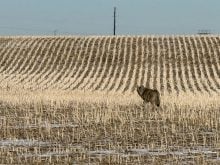It’s time to swath that canola crop. But many prairie canola producers have a few different crops in the same field.
Drought and cool spring temperatures led to poor germination and retarded development this year. When rain did come, it advanced those plants that got an early start, while causing germination in others. The result is canola at various stages of maturity.
Wait too long to swath and the early plants will shatter out; go too early and poor seed set and green seeds are the result.
Read Also

Agritechnica Day 3: Hybrid drive for a combine, data standards keep up to tech change and tractors of the year
Agritechnica 2025 Day 3: Hybrid drive for a combine, data standards keep up to tech change and tractors of the year.
David Vanthuyne of the Canola Council of Canada said the optimum stage of maturity to swath canola for both yield and quality is when the average seed colour change (SCC) reaches 60 percent within the field.
“Tough part this year is that 60 percent SCC over a whole field will mean a large portion of the plants will be 80 (percent SCC) or better along,” he said.
“That means shattering losses. Go early and you get shrunken seeds and greens.”
The council recommends that producers begin swathing when the most mature plants are at 60 percent colour changed, or a little more. Later plants should have at least some colour change in the pods at the base of the main stems and the upper pods should have seeds that are dark green and firm to the touch.
This should minimize shatter losses. It also gives the later plants the opportunity to dry down with less yield loss due to shrinkage and with time, and some moisture, allows the chlorophyll to cure out of the green seeds.
Swathing should be done early or later in the day when it is cooler and the humidity is higher, to avoid shattering of mature pods.
Where the plants are highly variable, producers should evaluate how much of the crop is ready to swath and base the decision on the likelihood of harvesting greater yields from the later plants than from those that are currently mature.














